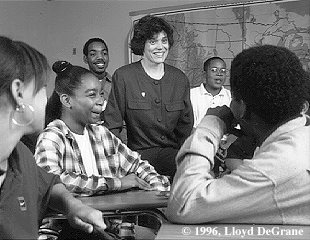
The University of Chicago Magazine
October-December 1996

Something went wrong when Anna entered high school. She'd finished eighth grade in the Chicago Public Schools with adequate academic skills. It hadn't been easy. But when a turbulent home life had threatened her elementary-school performance, personal attention from Anna's teachers had helped her pull through. Then came ninth grade, with tougher subjects, a vastly bigger school, and greater freedom, either to flourish or flounder. Anna's first-semester grades were mostly D's and an F. In Chicago's public high schools, Anna's rocky start is typical. Over 40 percent of ninth graders fail one core subject in their first term, and almost a quarter fail two or more courses. These numbers, matched with stories of students like Anna, come from a study by SSA assistant professor Melissa Roderick--published this past summer by the independent, U of Cbased Consortium on Chicago School Research (headed by education professor Anthony Bryk). In contrast to improvements at some Chicago elementary schools since the late 1980s, when reforms began, the city's high schools remain in a dismal state, say Roderick and the consortium. But there's a hopeful side to the specificity with which Roderick has analyzed the problem. To school leaders, her diagnosis suggests equally specific solutions. Some changes are significant yet inexpensive, and some are already afoot. Roderick's chapter of the consortium report--which focuses on student experiences in the city's schools--springs from her conviction that the transition to high school is a critical time in an adolescent's later decision to drop out. Many big-city high schools, she says, fall down at exactly this point, losing kids like Anna years before they actually stop attending school. To Roderick, who first focused on the high-school transition in her 1991 Harvard dissertation, 14- to 16-year-olds live between two worlds: ready for new independence, but still needing a teacher-parent safety net. Most Chicago ninth graders get independence aplenty, but little else. They attend high schools with no homerooms or advisers, each day rushing between seven different classrooms amid a grade-level group that is five times larger, on average, than their eighth-grade class. Their schools draw students from as many as a dozen elementary schools; parental involvement, compared to elementary school, is minimal; and student-teacher relationships are far less close. "As you move into high school," Roderick comments bluntly, "you need more independence, but you don't need to be thrown off the top of the Sears Tower." A disturbing metaphor, but one that she supports with evidence both wide and deep. From transcripts, Roderick and Eric Camburn, AM'89, a consortium researcher, analyzed patterns of course failure among the high schools' entire 1992 entering class--some 27,600 ninth graders. To understand the high-school transition from a student's perspective, she is also following 98 students from the end of eighth to the end of tenth grade, periodically interviewing them, their teachers, and their parents. Roderick hopes the mix of qualitative and quantitative work will be a model for policy research. One approach explains and dramatizes the other, she says, with "a number in one hand and the story of a kid in the other." The 98 ongoing interviews have required an eight-person team--mostly U of C graduate students in human development or social work--and the cooperation of three schools from the city's south, west, and north sides. Daunting logistical challenges, like locating peripatetic teachers whose classroom schedules confused even the team's Ph.D. students, have proven an unexpected source of insight. Imagine, says Roderick, the roadblock of such a schedule to a 14-year-old hoping to meet her teacher for extra help outside of class. Both the transcript study and the first year of student interviews found shocking rates of course failure and absenteeism--relatively minor problems at the elementary-school level, according to other research by the consortium. Ninth graders fail, Roderick and Camburn write, because they have academic skills too weak for high school's more difficult material, and because their study skills are inadequate for the new freedoms, varied teaching styles, and radically different environment. In interviews, eighth graders were well aware of the dangers ahead, telling the researchers again and again, "I don't want to drop out." But, says Roderick, "Fear of dropping out isn't enough to know how to solve a problem, like seeking help, getting a class changed." Her major findings expose the problem's institutional nature. Even students starting ninth grade with math and reading skills above national averages face a 25-percent chance of failing a course in their first term. And nothing suggests that high schools, absent their weakest students, do fine: Failure rates at the end of tenth grade, after 10 percent of students have dropped out, exceed those after the first semester of ninth grade. Many students still in school have failed or skipped too many classes to catch up. "You see kids with this vision of keeping on track," Roderick says. They're no longer learning, just "playing school." A central lesson is that failure leads to more failure. The chance of "recovery," or passing all courses after at least one failure the prior term, is less than one in three. "The real failure of high schools," Roderick concludes, "is that when 14-year-olds start to mess up--and they will mess up--our high schools are not organized to provide the help they need." A handful of Chicago schools do catch kids who fall, at least some of the time. Across the city, ninth graders' recovery rates varied from 11 to 52 percent--after adjusting statistically for the different attendance habits, demographic character, and prior achievement levels of each school's student body. To Roderick, this variation shows that the high schools' problems can't be written off as a poverty issue. "That's the fallacy--that urban kids need something suburban kids don't," she says. "No: Urban students need something suburban students are getting." What ninth and tenth graders need first, she suggests, are smaller schools: a core group of teachers, in one location, educating just a few hundred students. "School-within-a-school" reorganizations can create small schools without the cost of bricks and mortar. A number of the city's larger schools have recently taken this course, and Roderick is among those helping Chicago public schools CEO Paul Vallas to spread this and other reforms during 1997. Smaller schools won't do it all, she cautions. Their hoped-for effects--teachers who collaborate closely and know students personally, parents who stay involved, and students who know where to reach for help--are long term. There are other needs, too: a more challenging curriculum and the student-oriented programs, such as homeroom advisories and ninth-grade transitional activities, whose lack Roderick often bemoans. Such programs aren't expensive, and Vallas recently committed the necessary funds, but implementing them will take big changes in schedules and teacher contracts. Research grants for Roderick's student-interviewing project, however, have proven scarce--a frustrating irony, given that the school community's "overwhelming" interest in such research is a big reason for Roderick's guarded optimism about Chicago's high schools. "All big school systems are facing the same set of problems," she commented soon after the report's release. But "Chicago's in a unique situation, because you have a central administration that's very committed to change, and a reform community that's very active--and then we've added this research." As her student subjects begin tenth grade, Roderick's research continues. Her team's initial interviews were "like reading the first chapter of a great novel," but no one foresees many happy endings for these kids. Perhaps, she hopes, for their younger sisters and brothers. Written by Andrew Campbell Go to: Schools Without a Net
Melissa Roderick listens in to learn why even good students in Chicago high schools often struggle.
 Going to the source: SSA professor Melissa Roderick talks to Chicago kids in transition.
Going to the source: SSA professor Melissa Roderick talks to Chicago kids in transition.More Investigations:
Also in Investigations:
Return to October-December 1996 Table of Contents